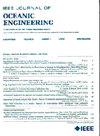Underwater Acoustic Preamble Detection via End-to-End Complex-Valued Synchrosqueezed Wavelet Neural Network
IF 3.8
2区 工程技术
Q1 ENGINEERING, CIVIL
引用次数: 0
Abstract
Preamble detection is critical in underwater acoustic systems due to its impact on reliability and operational coexistence. Traditional methods are limited due to the types of interference found in underwater environments, which can easily falsely trigger the system. In this study, we propose an end-to-end neural network for preamble detection, using a single deep learning model without preprocessing. Our approach employs a simple convolutional neural network architecture with a minimal number and size of layers. We integrate neural network with time–frequency analysis knowledge via the complex-valued wavelet synchrosqueezing layer to extract crucial time–frequency features, which is essential for distinguishing the preamble from underwater acoustic interferences. In addition, we adapt the network to handle complex values, capturing both magnitude and phase information in preamble signals. Experimental results demonstrate that, even with similar preamble interferences, our proposed network, leveraging the Morlet mother wavelet under the LeNet1d framework, exhibits superior detection performance compared to conventional networks. Notably, the performance is very robust even with a small training data set and small computational complexity, highlighting the effectiveness of the network's knowledge-based design.通过端到端复值同步小波神经网络进行水下声学前导信号检测
导流探测对水声系统的可靠性和工作共存有着重要的影响。传统的方法受到水下环境中各种干扰的限制,这些干扰很容易错误地触发系统。在本研究中,我们提出了一个端到端神经网络用于序言检测,使用单个深度学习模型而不进行预处理。我们的方法采用了一个简单的卷积神经网络架构,具有最小的层数和大小。我们通过复值小波同步压缩层将神经网络与时频分析知识相结合,提取关键时频特征,这是区分引言和水声干扰的必要条件。此外,我们调整网络来处理复杂的值,同时捕获前置信号的幅值和相位信息。实验结果表明,即使有类似的前导干扰,我们提出的网络,利用LeNet1d框架下的Morlet母小波,与传统网络相比,表现出更好的检测性能。值得注意的是,即使在较小的训练数据集和较小的计算复杂度下,性能也非常稳健,突出了网络基于知识设计的有效性。
本文章由计算机程序翻译,如有差异,请以英文原文为准。
求助全文
约1分钟内获得全文
求助全文
来源期刊

IEEE Journal of Oceanic Engineering
工程技术-工程:大洋
CiteScore
9.60
自引率
12.20%
发文量
86
审稿时长
12 months
期刊介绍:
The IEEE Journal of Oceanic Engineering (ISSN 0364-9059) is the online-only quarterly publication of the IEEE Oceanic Engineering Society (IEEE OES). The scope of the Journal is the field of interest of the IEEE OES, which encompasses all aspects of science, engineering, and technology that address research, development, and operations pertaining to all bodies of water. This includes the creation of new capabilities and technologies from concept design through prototypes, testing, and operational systems to sense, explore, understand, develop, use, and responsibly manage natural resources.
 求助内容:
求助内容: 应助结果提醒方式:
应助结果提醒方式:


